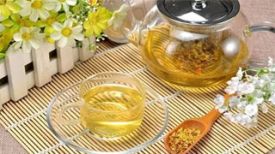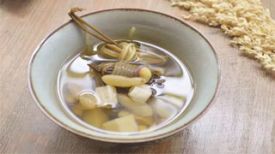Kunbu is a perennial large brown algae that mainly grows in the ocean, especially in cold seas. Kunbu is usually in a flat strip shape with broad leaves. The surface of fresh Kunbu will have a layer of mucus juice, forming a layer of gum, which also gives it a unique, sticky, crispy, and sweet taste. Kunbu is inexpensive, nutritious, and has a unique taste, often appearing on people's dining tables.
The "little expert" in eradicating "dissidents"
Kunbu has a salty taste, a cold nature, and belongs to the liver, stomach, and kidney meridians. It has the effects of resolving phlegm, softening hardness, promoting diuresis, and reducing swelling. For those who suffer from diseases such as galls, scrofula, testicular swelling and pain, or those who are prone to edema, they can take Kunbu appropriately, which is beneficial for reducing swelling and dispersing nodules, and removing "garbage" from the body.
Modern research has found that Kunbu is rich in polysaccharides such as alginate, Kunbu extract, and galactose, as well as amino acids such as seaweed amino acid, glutamic acid, aspartic acid, proline, as well as vitamins C, P, carotene, and minerals needed by the human body such as iodine, potassium, calcium, and iron. Taking Kunbu appropriately can not only supplement nutrients to the body, improve physical fitness, enhance immune function, but also have effects such as lowering blood lipids, lowering blood pressure, and lowering blood sugar.
Kunbu and kelp are "cousins"
Both kelp and laminaria belong to the order Laminaria, but because they are not plants of the same family or genus, even if they look similar, they are not "brothers" and can only be called "cousins".
Kelp is the dry leaf like body of plants in the family Laminaceae of the order Laminaria, while Kunbu is the dry leaf like body of plants in the family Platycodontidae of the order Laminaria. The two are not marine products of the same family and genus. However, due to their similar appearance, similar ingredients, and rich iodide content, these two types of seafood can be used to prevent and treat iodine deficiency induced thyroid enlargement, so they are often mixed up by many people in daily life. Traditional Chinese medicine believes that both kelp and kumquat have the effects of resolving phlegm, softening hardness, promoting diuresis, and reducing swelling. Therefore, when used clinically, they are not specifically distinguished, but both are used as kumquat.
Seafood Tonic Diet Recipe
Cold mixed Kunbu silk
【 Ingredients 】 60g Kunbu, appropriate amounts of chopped scallions, ginger, salt, vinegar, and soy sauce each
[Method]
1. Soak Kunbu in warm water until soft, then put it into a steamer and steam with water for 15 minutes.
2. Cut the steamed Kunbu into thin shreds, mix in the above seasonings, and then it can be consumed.
【 Effect 】 Take once, once a day. Can effectively alleviate constipation.
Kunbu Stewed Tofu
[Ingredients] 220g tofu, 80g kumbu, appropriate amounts of scallions, ginger powder, edible oil, and essential salt each
[Method]
1. Soak Kunbu in water, wash it clean, and shred it; Boil tofu with clean water, remove and drain, and cut into small cubes.
2. Stir fry scallions and ginger in oil until fragrant, then add Kunbu and tofu and continue to stir fry for 1 minute. Add an appropriate amount of water, bring to a boil over high heat, then simmer on low heat for 10 minutes. Add salt and stir well before consumption.
【 Effect 】 Take once, once a day. It can clear heat, generate saliva, and moisten dryness, and can be used for nourishing and consuming for those who suffer from hyperlipidemia, obesity, cough, thirst, and other symptoms.
Kunbu Cassia Decoction
【 Ingredients 】 60g Kunbu, 40g Cassia seed, 10g sesame oil, 2g salt
[Method] Wash Kunbu and Cassia seeds, and then soak Kunbu in an appropriate amount of water for 2 hours; Pour Kunbu and soaking water into a pot, bring to a boil over high heat, then reduce to low heat and continue to cook for 5 minutes. Add salt and sesame oil to season, stir well and serve.
【 Effect 】 It can be consumed twice a day to clear liver fire, lower blood pressure, and is suitable for daily use by patients with hypertension such as dizziness, tinnitus, headache, redness, irritability, bitter mouth, red face, and constipation.
High iodine algae is not suitable for everyone to eat
Kunbu has a cold nature, so those with spleen and stomach deficiency and indigestion should avoid eating; Kunbu, kelp and other kelp plants are rich in iodine, so patients with hyperthyroidism should not eat them to avoid worsening the condition. Pregnant and lactating women should not eat too much, as a large amount of iodine can enter the fetal (infant) body with blood circulation, which may cause thyroid dysfunction in the fetus (infant).
Iodine containing seafood should not be used together with isoniazid or cardiac glycosides to avoid causing high blood potassium levels and affecting drug efficacy.
This food can help clear the body of garbage, and people at the beach can eat it every day
Release time:2024-06-05 16:09:54
Reading:197
Word Count:4954
Subscribe to email


